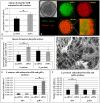Streptococcus mutans-derived extracellular matrix in cariogenic oral biofilms
- PMID: 25763359
- PMCID: PMC4327733
- DOI: 10.3389/fcimb.2015.00010
Streptococcus mutans-derived extracellular matrix in cariogenic oral biofilms
Abstract
Biofilms are highly structured microbial communities that are enmeshed in a self-produced extracellular matrix. Within the complex oral microbiome, Streptococcus mutans is a major producer of extracellular polymeric substances including exopolysaccharides (EPS), eDNA, and lipoteichoic acid (LTA). EPS produced by S. mutans-derived exoenzymes promote local accumulation of microbes on the teeth, while forming a spatially heterogeneous and diffusion-limiting matrix that protects embedded bacteria. The EPS-rich matrix provides mechanical stability/cohesiveness and facilitates the creation of highly acidic microenvironments, which are critical for the pathogenesis of dental caries. In parallel, S. mutans also releases eDNA and LTA, which can contribute with matrix development. eDNA enhances EPS (glucan) synthesis locally, increasing the adhesion of S. mutans to saliva-coated apatitic surfaces and the assembly of highly cohesive biofilms. eDNA and other extracellular substances, acting in concert with EPS, may impact the functional properties of the matrix and the virulence of cariogenic biofilms. Enhanced understanding about the assembly principles of the matrix may lead to efficacious approaches to control biofilm-related diseases.
Keywords: Streptococcus mutans; biofilms; dental caries; eDNA; exopolysaccharides; extracellular matrix; mechanical stability; spatial heterogeneities.
Figures


References
-
- Bourne M. C. (2002). Food Texture and Viscosity—Concept and Measurement. London: Academic Press.
-
- Bowen W. H. (1972). The effect of dextranase on caries activity in monkeys (Macaca irus). Caries Res. 6, 75–76. - PubMed
Publication types
MeSH terms
Substances
Grants and funding
LinkOut - more resources
Full Text Sources
Other Literature Sources
Medical

